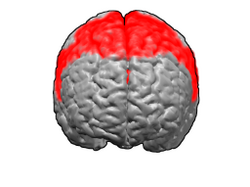Premotor cortex
| Premotor cortex | |
|---|---|

Image of brain with Brodmann areas numbered
|
|

|
|
| Details | |
| Part of | The Brain |
| Artery | Middle cerebral artery |
| Identifiers | |
| Latin | Cortex praemotorius |
| NeuroNames | ancil-44 |
|
Anatomical terms of neuroanatomy
[]
|
|
The premotor cortex is an area of motor cortex lying within the frontal lobe of the brain just anterior to the primary motor cortex. It occupies part of Brodmann's area 6. It has been studied mainly in primates, including monkeys and humans. The functions of the premotor cortex are diverse and not fully understood. It projects directly to the spinal cord and therefore may play a role in the direct control of behavior, with a relative emphasis on the trunk muscles of the body. It may also play a role in planning movement, in the spatial guidance of movement, in the sensory guidance of movement, in understanding the actions of others, and in using abstract rules to perform specific tasks. Different subregions of the premotor cortex have different properties and presumably emphasize different functions.
The premotor cortex occupies the part of Brodmann area 6 that lies on the lateral surface of the cerebral hemisphere. The medial extension of area 6, onto the midline surface of the hemisphere, is the site of the supplementary motor area, or SMA.
The premotor cortex can be distinguished from the primary motor cortex, Brodmann area 4, just posterior to it, based on two main anatomical markers. First, the primary motor cortex contains giant pyramidal cells called Betz cells in layer V, whereas giant pyramidal cells are less common and smaller in the premotor cortex. Second, the primary motor cortex is agranular: it lacks a layer IV marked by the presence of granule cells. The premotor cortex is dysgranular: it contains a faint layer IV.
The premotor cortex can be distinguished from Brodmann area 46 of the prefrontal cortex, just anterior to it, by the presence of a fully formed granular layer IV in area 46. The premotor cortex is therefore anatomically a transition between the agranular motor cortex and the granular, six-layered prefrontal cortex.
The premotor cortex has been divided into finer subregions on the basis of cytoarchitecture (the appearance of the cortex under a microscope), cytohistochemistry (the manner in which the cortex appears when stained by various chemical substances), anatomical connectivity to other brain areas, and physiological properties. These divisions are summarized below in Divisions of the premotor cortex.
...
Wikipedia
